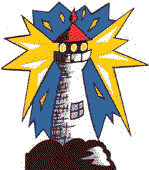|

Home Page Issues Page Poo Page
From TCP # 12 Miles Lewis is a retired marine waste expert that wrote an enlightening letter to TCP that was later reprinted in the form of a regular article. This is the truth of what effect boat sourced sewerage has on the sea.
The Real Scoop on Poop HOW THE GOVERNMENT HAS IT WRONG! by Miles Lewis
California USAMy viewpoint results from 10 years as a geologist, 18 years as a marine waste disposal consultant/oceanographer, 10 years as an environmental remediation engineer, and finally, 10 years as a retired "Natural Scientist" with an Ericson 39 sailboat.
Biological activity, especially in tropical & sub-tropical seas, is invariably limited by a shortage of nitrates & phosphates. Animal excrement is the primary source of these vital materials. Seaweed can not grow without it. It seems that the Queensland bureaucrats are proposing astronomical fines for anyone caught disposing such material from a boat even though pump-out facilities are almost non-existent. It is noted that swimmers are exempt from such laws. Those who demand that legislators "do something about the problem" should consider the following: Whales, dolphins, pinnipeds, & sea otters have been around from 50 to 10 million years and every one of them has pooped into the ocean. Fish have been doing it for 450 million years. Even man has been using seas, lakes & rivers for sewage disposal for millennia. The tonnage of excrement flowing down just one Chinese river dwarfs that from all the yachts in the world.
Coliform bacteria quickly die in seawater. So do nearly all human pathogens. The ocean is the world's largest "chlorinator."
Escherichia coli, more commonly known as E. coli is just one of many of these enteric bacteria that all mammals have in their digestive systems and in their poop. These coliforms are the ones counted in beach water samples by health departments around the world. Higher coliform counts are considered to indicate the higher probability that pathogens, disease causing bugs, are also in the sample. When it rains on coastal lands, the fresh storm water washes dog poop, bird droppings, fertilizer & everything else down the creeks, rivers, storm drains, etc, into the ocean & dilutes the normal saline seawater of the beaches in the vicinity of these outfalls. As a result, coliform counts often rise from a normal range of 3 to 30 per cubic centimetre of seawater to 300 to 3000/cc usually found in freshwater samples. Brackish water will have intermediate counts. Raw sewage has counts into the millions.
When I conducted a survey of the ocean waters off the Long Beach - Los Angeles - Palos Verdes area for the fledgling EPA in 1973, we collected top, middle & bottom water samples plus a bottom sediment grab at 66 stations. The stations were in a 3 X 22 grid at half mile intervals or covering a 1 ½ mile wide strip by 11 miles long from the Long Beach Harbour entrance (Queens Gate) to Twin Points on the Peninsula. We tested the water & mud samples for many things: heavy metals like arsenic, mercury, lead, etc; pesticides like DDT, DDE, etc; nitrates & phosphates; normal oceanographic parameters such as dissolved oxygen, salinity (chlorinity), pH, turbidity, dissolved & suspended solids, etc. We also tested the water samples for coliform count. There were 198 water samples (3 X 66). Ted Achrem, who worked for me as a diver & marine tech, put phoney labels on two more sample bottles & filled them from our office drinking fountain, to make an even 200 samples to be run by the labs. The resulting coliform counts on 196 of the samples were typically 3, 7, 11, up to 21. Two samples of bottom water collected directly over discharge points on the Los Angeles County sewage outfall line that extends seaward from Whites Point near San Pedro measured 112 & 224. The two from our drinking fountain had counts of 1120 & 2240, exactly an order of magnitude higher than our worst sea water samples ! ! !
When I wrote up the Conclusions section of our survey report to the EPA, I stated: "It is obviously safer to swim at Whites Point than to take a bath in Anaheim." My boss, Dick Timme, said "You can't put that in a scientific report'" & made me rewrite it! From the above, it is certainly clear that mammalian enteric bacteria do not prosper in seawater with normal salinities of 33 parts per thousand & why beaches are "polluted" after rains.Laws requiring that boaters "treat" their sewage should only apply on freshwater lakes & rivers. Maceration does little to reduce adverse health effects of raw sewage, but it does allow more rapid disinfecting by seawater. Otherwise, it serves only cosmetic or aesthetic purposes.